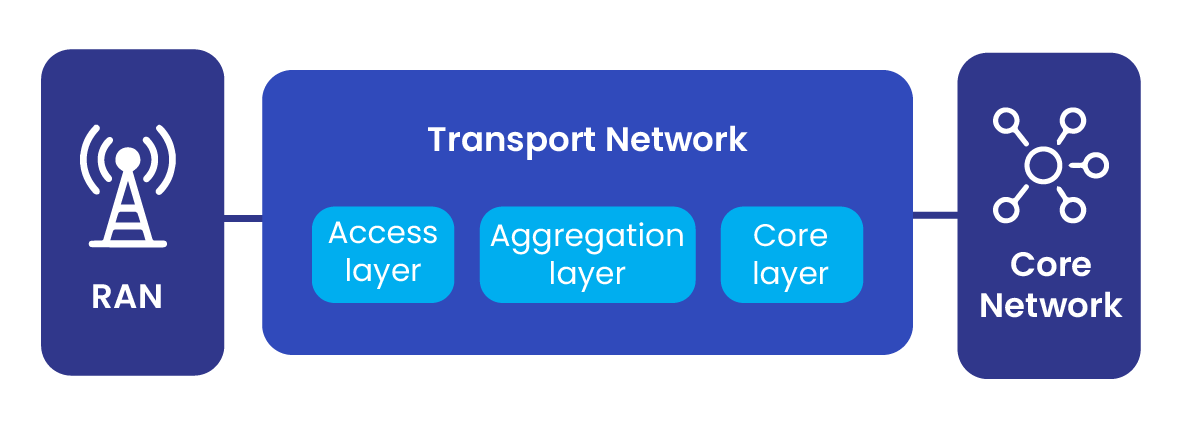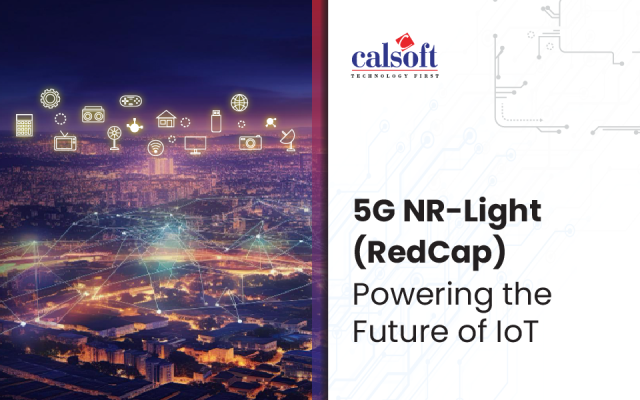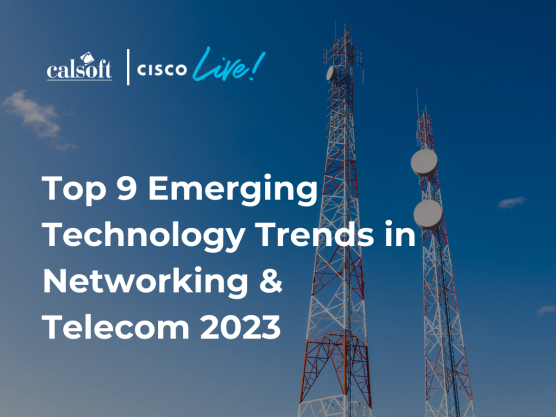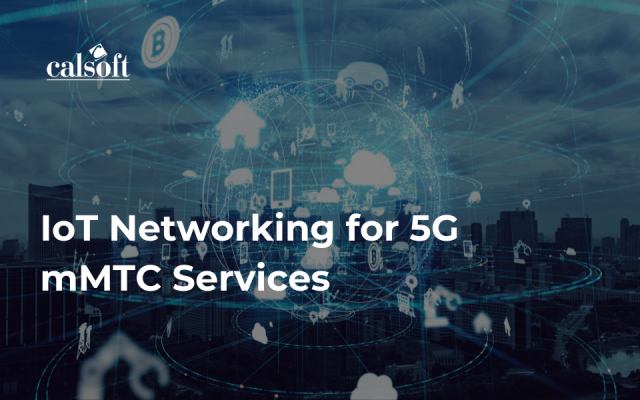The telecom industry is evolving rapidly to meet the changing demands of end users. The telecom Service Providers (SPs) started the 5G journey recently in 2018 expecting to bring in enhanced network coverage and capacity. However, to meet the specific user demands, the telecom operators should not only migrate from cellular generations (2G-3G-4G-5G), but also need to upgrade their network architecture.
The 5G and beyond technologies are expected to realize massive machine type and ultra-low latency services. To realize these advanced 5G requirements, it is necessary to upgrade the network architecture from end-to-end. The telco industry is witnessing rapid network transformation towards a virtualized Radio Access Network (v-RAN), Open RAN, and a service-oriented Core Network (5G Core). The advancements in transport architecture are also a key to efficiently deliver reliable 5G services.
Read the blog to explore 5G transport technologies and the key advancements in transport architecture.
What is xHaul Network?
A mobile communication network consists of access, transport, and the core network. Each of these parts of the network should evolve to support the specific technical requirements 5G use cases such as enhanced Mobile Broadband (eMBB), ultra-reliability and Low-Latency Communication (uRLLC), and massive Machine Type Communication (mMTC).
As shown in Fig.1, the transport network connects the access layer to aggregation data centers and the core network. The RAN comprises base stations, radio units or access points or small cells that wirelessly communicate with the end-users. The transport network controls the data transfer and traffic between the RAN and the core network to provide services like voice, video, or further applications. The blog focuses on the evolution that is necessary for the transport network to support many exciting 5G applications.
The transport network needs to evolve to meet the technical requirements of the 5G use cases in terms of data rate (bandwidth), latency, flexibility, scalability, and intelligence. The eMBB use case is expected to support a peak data rate of nearly 20 gigabits per second. Whereas mMTC must support a massive connectivity of 1 million devices per square kilometer. Hence, the transport links in 5G networks are expected to provide 10 to 50 gigabits per second at the access layer, 100 to 400 gigabits per second at the aggregation layer and 400 gigabits per second at the core layer. Similarly, in uRLLC services the overall end-to-end latency should be less than 1 millisecond. Therefore, it becomes necessary to choose appropriate network capabilities and transport technologies to serve diverse 5G use case scenarios.
The 5G transport network, also known as xHaul as shown in Fig 2 can be categorized as mobile fronthaul, midhaul and backhaul networks. In LTE or 4G, fronthaul network is the link between Remote Radio Heads (RRHs) and distant centralized/cloud Baseband Units (BBUs), whereas backhaul is the link between BBUs and the 4G Evolved Packet Core (EPC). In 5G RAN, BBUs are disaggregated and virtualized into Centralized Units (CUs) and Distributed Units (DUs). The 5G Radio Units (RUs) connect to DU via fronthaul, the link between DU and RU is known as midhaul, and CU connects to the 5G Core (Learn more about 5G core through this blog 5G Service Based Architecture ) via backhaul.
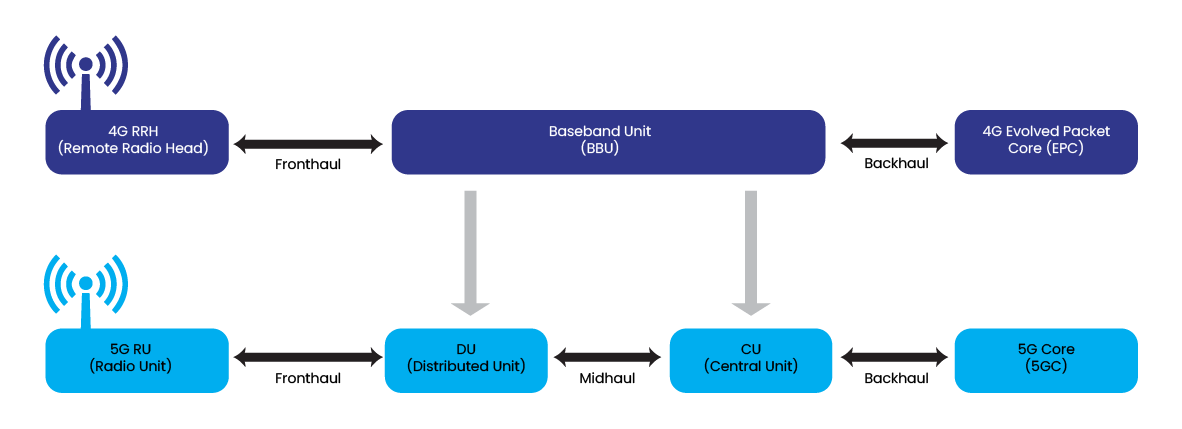
The 5G RAN can be deployed as per the mobile operators’ desires and demands. The CU-DU interface is known as the Higher Layer Split (HLS), and the RU-DU split is called the Lower Layer Split (LLS). The HLS is delay tolerant whereas LLS demands higher bandwidth and very low latency services. The distribution of these modules (RU/DU/CU) in the RAN framework depends on the service requirements to be met. RU, DU, and CU can be placed at the cell site, transport aggregation locations or at the edge locations. For example, in uRLLC service, RU, DU and CU should be integrated and deployed close to the application scenario. However, in HLS, DU can be placed at the cell site together with RU. Therefore, the distribution of these modules is dependent on the service requirements and availability of a good transport network in different regions (network topologies vary in rural/sub-urban/urban regions). To know more about 5G RAN, read the eBrief Intelligent and Automated 5G RAN.
The requirement of low latency introduces new network topologies and functional split options, demanding lesser distance between user and compute. This necessitates the need for a flexible and scalable transport framework in 5G.
Mobile Network Operators (MNOs) focus on innovative xhaul transport technologies to realize high performance and reliability for 5G services. The xhaul transport can be wired or wireless based on the requirements to be met. 5G xHaul transport has become more flexible, scalable, and intelligent with key technologies such as Network Function Virtualization (NFV), Software Defined Networking (SDN), and Network Slicing. To explore more details, visit SD-WAN
Different transport technologies can be used to support xHaul networks.
- Microwave: This technology can ensure a Gbps bandwidth, ultra-low latency of nearly 25 microseconds per site, and support slicing. By utilizing SDN technologies, microwave realizes flexible and intelligent operations and maintenance processes. The microwave is evolving continuously by employing technologies such as high-order and adaptive modulation, dual band antennas, carrier aggregation and more. Microwave technology is also suitable for providing connectivity for Private 5G Networks.
- Fiber Optics: Optical Fiber technology can support higher bandwidth and low latency communications. 5G needs to support big data processing to enable IoT communication. To manage massive amounts of data, 5G demands very high frequencies, that are feasible for shorter distances. 5G works on a diverse set of frequencies ranging from sub 6GHz to 24 GHz frequencies for massive coverage and connectivity. Hence, high quality fiber optics becomes an apt choice for ensuring high speed network availability.
- Ethernet-based Fronthaul: The most challenging interface in 5G transport is the fronthaul interface between RU and DU. The packet based evolved Common Public Radio Interface (eCPRI) has been introduced to support 5G NR and massive Multiple Input Multiple Output (MIMO) systems. This packet based fronthaul interface can ease the excessive bandwidth requirements and lower the operational and maintenance cost for transport deployments. In addition, the packet based fronthaul can scale flexibly the required bandwidth as per the data traffic variations.
- Integrated Access Backhaul (IAB): This wireless backhaul solution realizes dense 5G deployments. The peculiarity of IAB is its flexible and scalable architecture, restricting the number of backhaul hops to the network performance demands.
- Satellite: In regions, where fiber connectivity cannot be maintained or is practically challenging, satellite backhaul is a solution. Wireless backhaul solutions or Non-Terrestrial Networks (NTN) are key to areas such as rural regions, where high speed wired connectivity becomes practically difficult.
- Time Sensitive Networking (TSN) Enabled Ethernet: TSN achieves time synchronization for 5G transport network covering backhaul and fronthaul, enabling very low congestion rate and supporting ultra-low latency services.
In Brief
The next-generation technology 5G realizes diverse services such as driverless cars, smart factories, telemedicine and more. To serve these services and their specific technical requirements in terms of bandwidth, latency and reliability, a transformational change is required in the overall architecture, extending access to transport and to the core. In this regard, an efficient transport framework is significant to meet the stringent latency and reliability requirements of 5G applications. The 5G architectural evolution is anticipated to encompass a more distributed, virtualized, and open framework, employing slicing techniques, and realizing frameworks with precise frequency or time synchronization. To facilitate innovation and advanced 5G deployments, a flexible, scalable, and resilient 5G transport network is crucial. 5G xHaul networks can support higher bandwidth and low-latency requirements and are scalable to meet the growing demands -of the services.
Calsoft, being a technology first company and a pioneer in cutting-edge technologies such as virtualization, SDN, SD-WAN, and computing can support telecom service providers to realize innovative solutions to stay at the forefront of network transformation.
Contact our 5G experts to get answers to your queries related to the 5G Network
References
[1] 5G Transport Network, Huawei
[2] Spotlight on 4G/5G backhaul networks, Ciena

